Abstract
In order to better understand the effect of compositional parameters on the properties of magnesium phosphate cement (MPC) mortar, the relationship between the thickness of paste film and the workability and strength of MPC mortar is revealed. A three-parameter filling density prediction model is adopted to study the filling density of sand with different gradations. The validity of the three-parameter filling density prediction model is validated by experimental results. The thickness of the paste film of MPC mortar is calculated with different sand gradations. The results show that the thickness of paste film has a great influence on the slump flow and strength of MPC mortar. The linear positive relationship between paste film thickness and slump flow of MPC mortar. At different sand-to-binder ratios, there is no significant linear relationship between the thickness of the paste film and the mechanical properties. But under the same sand-to-binder ratio, there is an optional thickness of paste film for the strength of the MPC mortar. Comprehensively considering the workability and mechanical properties, magnesium phosphate cement mortar’s optimal paste film thickness ranges from 73 µm to 74 µm. When designing the proportion of magnesium phosphate cement, the appropriate thickness of the paste film can be selected according to the different engineering types and construction environments.
1. Introduction
Magnesium phosphate cement (MPC) mortar consists of sand and paste. One part of the paste is used to wrap the sand, and the other part is used to fill the gap between the sand particles. At present, the fine aggregates commonly used in MPC mortar systems are river sand, machine-made sand, standard sand, slag, steel slag, etc. [1,2,3]. Moreover, research conducted by various scholars indicated that the MPC mortar prepared with aluminum sand, magnesia, and MPC exhibited superior mechanical performance [2].
Regarding the mechanical properties of MPC, the fineness of magnesium oxide, retarder dosage, and P/M (phosphate to magnesium) ratio notably affect its strength. Yang [4,5] and Jiang Hongyi [6,7]’s experiments showed that increasing MgO fineness boosts early strength but has little impact on later strength. However, as retarder dosage rises, the strength of MPC, especially early strength, drops quickly. Also, factors like water–binder ratio, P/M ratio, sand–binder ratio, and specimen size all influence specimen strength. Hall Stevens [8,9] pointed out that factors like retarders and the water–binder ratio have a significant impact on the strength and elastic modulus of MPC materials. The strength and modulus of the cement vary depending on different types of retarders. When sodium tripolyphosphate serves as a retarder, the cement strength initially rises and then declines as the retarder dosage goes up. With the exception of the 3 h elastic modulus that continuously diminishes with the increase in retarder dosage, the modulus at 6 h, 24 h, 7 days, and 28 days first goes up and then down. Concerning the influence of boric acid and borax on the strength and elastic modulus, the 3 h and 6 h elastic moduli, as well as the strength, continuously decrease as the retarder dosage increases, while the modulus and strength at 24 h, 7 days, and 28 days first ascend and then descend as the retarder dosage increases. Additionally, as the water–binder ratio grows, the strength and elastic modulus of MPC materials decline rapidly. According to research results, additives could influence the workability, high—early strength, porosity, and chemical corrosion resistance of MPC mortar and concrete. The additives included fly ash, silica fume, and metakaolin. Using fly ash in MPC materials enhances the workability [10], strength [11], and setting time [12]. Some researchers note that SF was used to enhance bonding strength [13], permeability [14], and corrosive resistance against chemicals [15]. Metakaolin could increase setting time [16], strength [17], and water resistance [18].
For MPC mortar, its filling characteristics significantly affect workability, mechanical properties, and porosity. Many scholars have developed a particle packing model to predict the packing density of granular materials. In the 1930s, Westman, Hugill [19], and Furnas [20] analyzed the packing structure within the particle skeleton. Considering the two limiting conditions of the size ratio (the ratio of the smaller particle size to the larger particle size), they realized the packing modeling of two single-particle sizes. Subsequently, Stovall [21] conducted a study on the structural effect between particle skeletons and provided a new interpretation. When fine particles are predominant, coarse particles will disrupt the regular accumulation of fine particles due to the wall effect, leading to large voids at the wall boundary of coarse particles. Conversely, when coarse particles are dominant, due to the loosening effect of fine particles, the filling of coarse particles will be loose, and fine particles will be squeezed into the gaps of coarse particles. The loosening effect of fine particles and the wall effect of coarse particles depend on the size ratio. Although the early Linear Packing Density Model (LPDM) could be used to predict to a certain extent [21], due to its linear nature, it exhibited corner features near the optimal value that did not conform to the actual situation, which prompted researchers to seek more sophisticated models. Against this background, the Solid Suspension Model (SSM) emerged [22]. It has provided a new perspective and more effective tools for optimizing ultra-high-performance concrete (UHPC). The SSM model is based on an in-depth understanding of the random arrangement of particles. By drawing on the model concept of Mooney, it has introduced new calculation methods. Compared with the LPDM model, the SSM model has achieved significant improvements in predicting the packing density, and its predicted results are more consistent with the actual experimental results. Meanwhile, this model can also be used to predict the solid content of a given viscosity suspension. The two-parameter model is a particle accumulation model that considers the loose effect and the wall effect through two parameters, but there is a certain error in the two-parameter model. In most of the two-parameter models, it is generally believed that the specific volume of the particle system is linear with the particle volume fraction of different particle size levels (each particle size level is a collection of single particle size particles). Still, the test results are just the opposite. Therefore, Yu and Standish et al. [23] extended the two-parameter model and introduced the concept of equivalent filler diameter in the two-parameter model. To improve the accuracy of the prediction model, Kwan [24] et al. introduced a new wedge effect parameter into the filling density prediction model to establish a three-parameter model. When smaller particles appear in the larger particle voids in the aggregate, they do not play a filling role but separate the larger particles, and the wedge effect will occur. However, the filling density prediction model now only applies to the binary mixture of regular shape particles, such as spherical particles, but the aggregates are mostly non-spherical irregular shape particles. To predict the filling density of irregularly shaped particles, Kwan and Wong et al. [25] extended the three-parameter model to the binary mixing of angular rock aggregate particles.
In MPC mortar, a part of MPC paste will fill the gap between materials, and the other part will wrap aggregate to form mortar film. The thickness of paste film is an important index that affects cement mortar fluidity, mechanical properties, and durability. Material type and water–cement ratio directly affect the thickness of the paste film. Tao Jun et al. [26] studied the influence of the paste thickness on concrete fluidity. The results show that as the paste thickness increases, the concrete slump flow will also increase. The study of Huang Jing et al. [27] showed a correlation between the paste thickness and the workability and rheological properties in UHPC. Li L G’s study [28,29] highlights the crucial role of paste thickness in regulating concrete deformability, fluidity, and strength. The study also identifies the optimal thickness range for the paste film to maintain good workability in cement-based materials.
Previous research mainly focused on the composition of cementitious materials, retarder dosage, water–binder ratio, P/M ratio, and mortar–cement ratio. Packing models were also restricted to their influence on cement mortar. However, the specific impact of paste film layer thickness on MPC mortar performance has not been studied. The study employed a three-parameter model to calculate and predict the filling density of sand. The accuracy of the model prediction was verified by comparing it with the filling density obtained from the test, which provides a reference for the design of aggregate in MPC mortar. The research also investigated the influence of different paste film thicknesses on the workability and mechanical properties of MPC mortar. These research results will help to understand the effect of mixing proportions on MPC properties.
2. Experiment and Raw Material
2.1. Raw Material
Yancheng Huanai Magnesium Industry Co., Ltd. in Jiangsu Province, China. provided the magnesium oxide (M) used in the experiment. The density of the returned MgO particles was 3.48 g/cm3, and the specific surface area was 920.6 m2/kg. The purity is 92%, and the relative molecular mass is 40.30. The color of the particles is light yellow, as shown in Figure 1. The particle size distribution of dead-burned magnesia is shown in Figure 2. The chemical composition is shown in Table 1. Industrial-grade ammonium dihydrogen phosphate (P), with the chemical formula NH4H2PO4, was selected as the phosphate. Provided by Liaoning Pengda Technology Company in Liaoning Province, China. The technical indexes are shown in Table 2. The retarders employed in the test were sodium tripolyphosphate, anhydrous sodium acetate, and borax. Provided by Liaoning Pengda Technology Company in Liaoning Province, China. Technical indexes of retarders are shown in Table 3, such as relative molecular mass, purity, and apparent density. Fly ash (FA) and metakaolin (MK) territory were used as auxiliary cementitious materials; FA density was 1.985g/cm3, and the specific surface area was 417 m2/kg. Gongyi Youxing Mineral Products Company in China’s Henan Province produced MK, and the average particle size was 1250 mesh. The main chemical composition of the auxiliary cementitious materials is shown in Table 4. The particle size distributions of the two mineral admixtures are shown in Figure 3 and Figure 4, respectively. The aggregate used is Zone II river sand with a fineness modulus of 2.7, and the technical specifications of the river sand are shown in Table 5.
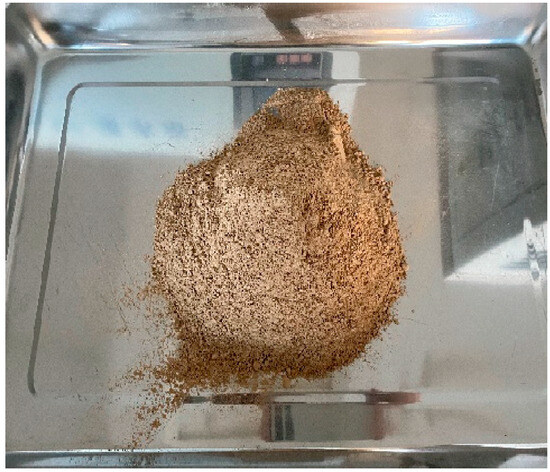
Figure 1.
Appearance of MgO.

Figure 2.
Particle size distribution of dead-burnt MgO.

Table 1.
Chemical composition of dead-burned MgO.

Table 2.
Technical indicators of ammonium dihydrogen phosphate.

Table 3.
Properties of retarders.

Table 4.
Main components of the auxiliary cementitious material.
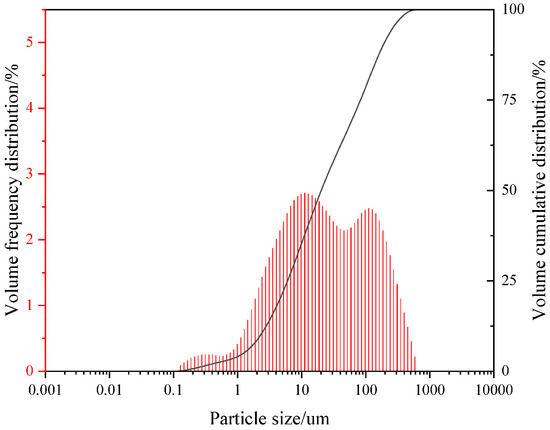
Figure 3.
Particle size distribution of FA.
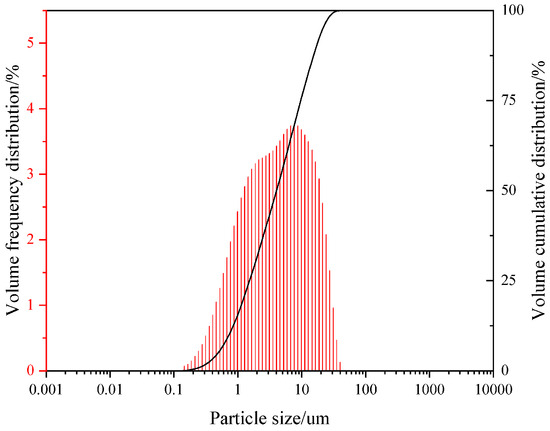
Figure 4.
Particle size distribution of MK.

Table 5.
Technical indicators of river sand.
2.2. Mixing Proportion and Experiment Method
2.2.1. Mixing Proportion
In this paper, in order to ensure that the MPC has better fluidity, the size range of sand is selected from 0.3 mm to 1.18 mm. Exploring the effect of different grades on the packing density of sand, the proportion of two gradations is from 0 to 1. In order to better explore the law of influence of sand grading on packing density. Two gradations of sand are used: 0.3 mm–0.6 mm and 0.6 mm–1.18 mm, respectively. The proportions of the two gradations of sand are shown in Table 6.

Table 6.
Proportions of sand.
The mixing proportions are carried out with 0.8 and 1.0 sand–binder ratios, respectively. Five gradations were designed with a particle size of 0.3 mm–0.6 mm in the aggregate of 30%, 40%, 46%, 50%, and 70%, respectively. The ratio of phosphorus to magnesium used in the test was fixed at 1/4. In the retarding component, 12% borax, 2% sodium tripolyphosphate, and 2% anhydrous sodium acetate were used, respectively. Magnesium oxide was replaced by 10% FA and 10% MK. The water–binder ratio was 0.17, and the sand–binder ratios were 0.8 and 1.0, respectively, as shown in Table 7.

Table 7.
Mixing proportion of MPC mortar.
Refer to GB/T 2419-2005 [30] “Test Method for fluidity of cement mortar” to test the slump flow of MPC mortar, and refer to GB/T 17671-2021 [31] “Test Method for cement mortar strength” for the test methods of flexural strength and compressive strength of MPC mortar. Dry measurements are commonly used to measure the filling density [32,33]. In the dry state, the mass and volume of MPC are free from the interference of water-related factors like evaporation, absorption, or flow. In contrast, the wet measurement method may cause dynamic changes in mass and volume during measurement because of water evaporation. The dry measurement method can offer more stable results and reflect the filling density of the material more accurately. In this study, the dry measurement method was chosen to measure and simulate the particle state in sand.
2.2.2. Experiment Method
(1) Filling density
Equipment is used to test the filling density of sand, which is produced by Beijing CCCCI Technology Development Co., Beijing, China. Precisely measure the volume V (accurate to 1 mL) of the container. Then, slowly pour the materials into the container through the funnel. When the filling reaches about 1/3 of the volume, make it preliminarily compact by shaking or a light vibration. Subsequently, continue to alternate the filling and vibrating operations. Each time when the filling reaches about 2/3 of the volume, perform vibration until the materials are close to the container’s mouth. Then, gently press the top with a flat plate to make the materials compactly piled up in the vertical direction and have a flat surface. Finally, weigh the container filled with the closely packed materials using the balance to obtain the mass m (accurate to 0.01 g). Calculate the filling density according to Equation (1) (accurate to 0.01 g/cm3).
Here, ρ is the filling density of sand, g/cm³, m is the mass of sand, g, V is volume, mL.
(2) Slump flow
The slump flow method is adopted to measure the fluidity of MPC mortar. A slump cone (as shown in Figure 5a) was used to measure the fluidity of MPC mortar, which height is 60 mm, and the diameters of the top and bottom ports are 70 mm and 100 mm, respectively. It is produced by Beijing CCCCI Technology Development Co., Beijing, China. A steel ruler for measuring the size of the mortar is required. Firstly, moisten the slump cone and place it on a horizontal surface. Then, load the mortar into the slump cone all at once until it reaches the top of the cone. Secondly, lift the slump cone vertically to allow the mortar to flow freely without interference until the flow stops (as shown in Figure 5b). Finally, use the steel ruler to measure the maximum and minimum diameters of the mortar and calculate their average value as the slump flow.
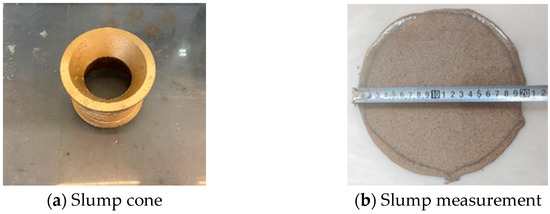
Figure 5.
Measurement process of MPC mortar slump.
(3) Compressive strength and flexural strength
In this experiment, molds with the size of 40 mm × 40 mm × 160 mm are used for the preparation of test specimens. The DYE—300 cement pressure testing machine is adopted to test their flexural strength and compressive strength (as shown in Figure 6), which is a microcomputer-controlled electronic pressure testing machine. It is produced by Zhongsitelang Measurement and Control Technology Co., Ltd. in Jiangsu Province, China. The 40 mm × 40 mm × 160 mm samples were tested for flexural strength at a loading rate of 50 N/s. Compressive strength was tested by the machine at a loading rate of 2400 N/s, as shown in Figure 5b. Three sets of specimens are prepared for each mix proportion. Three of them are for testing flexural strength, and six are for testing compressive strength. The average value is taken as the final strength.
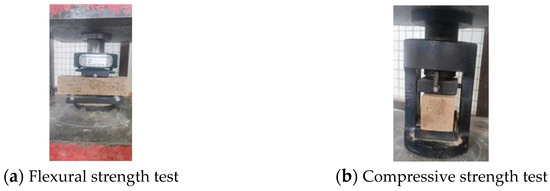
Figure 6.
Mechanical property test of MPC mortar.
2.3. Calculation of Three-Parameter Model and Paste Film Thickness
The parameters of the three-parameter model in this study are calculated as shown in Equations (2)–(4). a is for loosening effect, b for wall effect, c for wedging effect, and s is the ratio of particle sizes of class i and j particles.
Equations (5) and (6) are the three-parameter model for predicting the calculation method of filling density. Here, ri is the volume ratio of i-level particle size particles; rj is the volume ratio of j-grade particle size (ri + rj = 1); φi is the filling density of i-grade particle size; φj is the filling density of j-grade particle size; φj* is the filling density of the binary mixed aggregate system when the i-level particle size particles are dominant; φj* is also the filling density of the binary mixed aggregate system when particles with j-grade particle size are dominant.
Equation (7) is the equation for calculating the thickness of the paste film, where δ is the thickness of the paste layer wrapped in the surface of the river sand (cm). Vpaste is the total volume of MPC paste (cm3). Stotal is the total surface area of river sand (cm2); Vp is the pore volume (cm3) of river sand accumulation state.
In the preparation of MPC mortar, since different materials are usually weighed by mass, aggregates with the same particle size typically have different shapes and equivalent diameters. Therefore, in this study, assuming that all aggregates are homogeneous rounded particles, the mean diameter was defined by classifying them in a step-by-step manner, and Equations (8)–(11) were used to calculate the mean diameter and the total Stotal. In the equation: n is the equivalent number of aggregate particles in the mixture; Vs is the total volume of aggregate (cm3); mi is the mass of grade i granular aggregate (g); ρi is the density (g/cm3) of i-grade granular aggregate; Vsingle is the volume of aggregate particles with equivalent particle size (cm3); Stotal is the surface area (mm2) of aggregate particles with equivalent particle size; dav is the aggregate equivalent diameter (mm); mi is the mass fraction of the particle size i particles; di is the average diameter of particle i (the average size of the diameter of two consecutive sieves: mm).
3. Results and Discussion
3.1. Filling Density Prediction and Test Results
Table 8 shows the calculation results of the three-parameter filling density prediction model. By bringing the calculation results into Equations (5) and (6), the filling density prediction results can be obtained. Finally, the minimum values in φi* and φj* are taken as the final results. The test results and prediction results of the filling density are shown in Table 9.

Table 8.
Predictive model calculation parameters of packing density.

Table 9.
Filling density prediction and test results.
Figure 1 compares the predicted and experimental values of the filling density for sand. As can be seen from Figure 7, as the proportion of 0.3 mm–0.6 mm volume ratio increases from 0 to 1, the filling densities of sand exhibit a trend of initially increasing and then decreasing. The value of filling density is changing from 0.739 to 0.773. This is due to the change in sand particle combination. As the small particle content rises, they fill large particle voids, making packing denser and increasing sand per unit volume, thus enhancing packing density. The predicted results of the filling density exhibit a high degree of fit with the test results. This indicates that the three-parameter prediction model employed can effectively predict the filling density of aggregates.
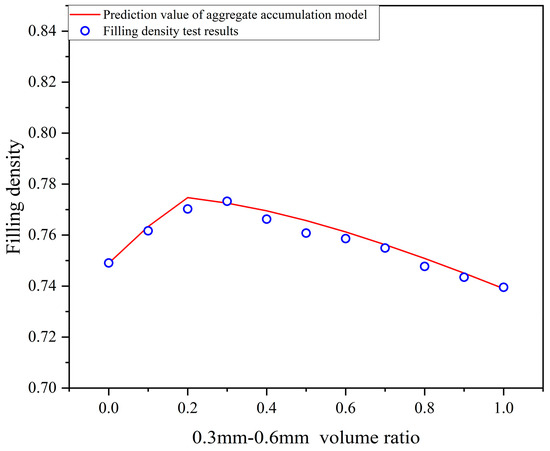
Figure 7.
Comparison of fill density predictions and test results.
3.2. Influence of Mortar Composition Parameters on the Thickness of MPC Paste Film Layer
According to Equations (7)–(11), the thickness of the paste film layer of each mixing ratio is calculated, and the calculation results are shown in Table 10.

Table 10.
Calculation parameters of MPC mortar paste film thickness.
Figure 8 presents the calculation results of the thickness of the paste film layer for different mixing proportions. It can be observed that as the sand–binder ratio increases from 0.8 to 1.0, the thickness of the paste film layer of the MPC mortar shows a significant decrease. For the same paste mixing proportions, the reduction is approximately 20%. The reason for that is that as the sand content increases, the number of particles with equivalent particle sizes also increases. In this situation, more MPC paste is required to fully encapsulate all the aggregates. However, ultimately, the thickness of the paste film is reduced.
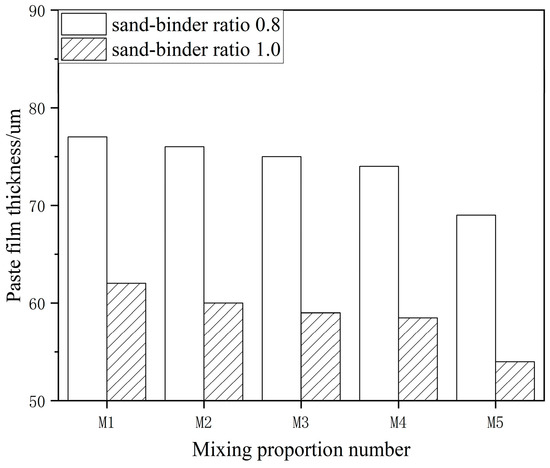
Figure 8.
The average paste film thickness of MPC mortar.
In addition, as the proportion of 0.3 mm–0.6 mm particles in the aggregate system increases, the thickness of the paste film layer of MPC mortar gradually decreases insignificantly. The reason for that is as the proportion of 0.3 mm–0.6 mm particles increases, the number of equivalent particle size aggregates will increase. It results that the total specific surface area of the aggregate particles will be rising. More paste is required to wrap the aggregate particles, consequently resulting in a decrease in the thickness of the paste film layer.
3.3. Relationship Between the Thickness of Paste Film and the Slump Flow of MPC Mortar
Figure 9 depicts the variation in the slump flow of MPC mortar with different thicknesses of paste film. The M1 group demonstrated the highest slump flow, with values of 270 mm and 220 mm for the sand–binder ratios of 0.8 and 1.0, respectively. Conversely, the M5 group had the lowest fluidity, with values of 235 mm and 190 mm for the same sand–binder ratios. An increase in the sand–binder ratio from 0.8 to 1.0 led to a slump flow loss of approximately 20% for different aggregate gradations. This loss occurs because the slump flow of MPC mortar is only achieved when the paste wraps the aggregate up to a specific critical value. As the sand–binder ratio increases, the thickness of the paste film will decrease, and the MPC paste between the aggregates will also decrease, thereby resulting in a reduction in the fluidity of the MPC mortar.
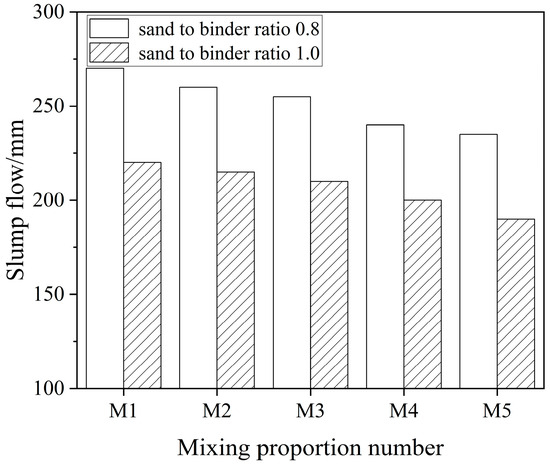
Figure 9.
Effect of mix proportion on fluidity of MPC mortar.
Figure 10 shows the relationship between the thickness of the paste film and the slump flow. The results show that MPC mortar’s slump flow increases with paste film layer thickness increase. The research results are consistent with those of Tao Jun et al. [26]. The fluidity of MPC mortar’s slump flow increases with the paste film layer thickness increase. The regression fitting curve shows that the relationship between slump flow and the thickness of the paste film presents a linear relationship. The thickness of the paste film layer is one factor affecting the fluidity of MPC mortar. Sholar reported that the sand-to-binder ratio by mass was dominantly affected by fluidity and strength [34]. The result is interesting. This article synthesizes the relationship between the thickness of the paste film layer and the fluidity, taking into account the sand volume and the paste volume. This will be more conducive to understanding the effect of mixing proportion parameters on the workability of MPC.
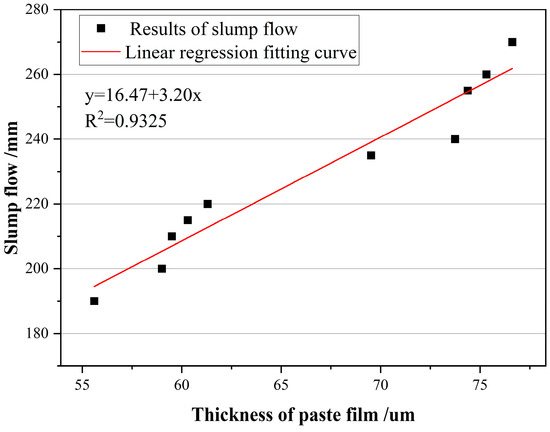
Figure 10.
The relationship between slump flow and paste film thickness.
3.4. Effect of Paste Film Thickness on Mechanical Properties of MPC Mortar
According to Figure 11, the flexural strength of MPC mortar varies with different sand gradations and sand–binder ratios. The flexural strength of 0.8 sand–binder ratio is higher than MPC mortar with 1.0 sand–binder ratio under the same sand gradation. Additionally, the highest flexural strength of MPC mortar was observed in the M2 group, which is 5.05 MPa, 6.60 MPa, and 8.95 MPa at three different curing ages. On the other hand, the M1 group with the same sand–binder ratio exhibited the lowest flexural strength, with 4.05 MPa, 4.9 MPa, and 7.0 MPa at 3 h, 1 d, and 28 d, respectively. Notably, the flexural strength of the M1 group was about 20% lower than that of the M2 group.

Figure 11.
Effect of river sand gradation on flexural strength of MPC.
Figure 12 shows the relationship between compressive strength and MPC mortars with different sand gradations under sand–binder ratios of 0.8 and 1.0. The compressive strength of the samples with a sand–binder ratio of 0.8 is slightly higher than samples with a sand–binder ratio of 1.0 under the same sand gradation. Under the same sand–binder ratio, as the proportion of 0.3 mm–0.6 mm particles increases, the compressive strength of MPC mortar initially increases and then decreases. Among the five gradations, the compressive strength of the M2 group is the largest. The compressive strengths at 3 h, 1 day, and 28 days are 26 MPa, 35.05 MPa, and 54.25 MPa. This phenomenon is attributed to the sand gradation. The 0.3 mm–0.6 mm particle size of river sand can have a good filling effect, and the 0.6 mm–1.18 mm particle size of river sand can play a good role in providing a skeleton, thereby making the MPC mortar structure dense. However, when the content of river sand with a particle size of 0.3 mm–0.6 mm continues to increase, a good skeleton cannot be formed, resulting in a decrease in the compressive strength of MPC mortar.
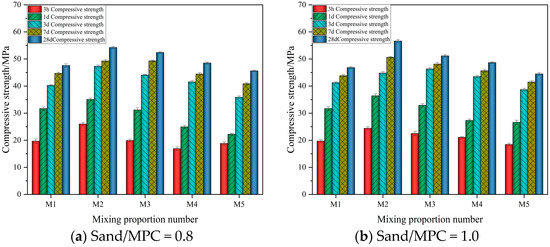
Figure 12.
Effect of river sand gradation on the compressive strength of MPC.
Figure 13 shows the influence of the thickness of the paste film on the 7d compressive strength under sand–binder ratios of 0.8 and 1.0. The thickness of the paste film layer is a crucial factor that impacts the compressive strength of MPC mortar. As the thickness of the paste film layer gradually increases, the compressive strength of MPC mortar initially rises and then declines. In the sand–binder ratio of 0.8 and 1.0, the optimal paste film thickness for obtaining the best compressive strength is 75.32 µm and 60.3 µm, respectively. Nevertheless, the influence of paste film thickness on compressive strength is less pronounced than that of a change in sand–binder ratio. Some scholars reported the relationship between sand characteristics and strength of MPC, such as sand volume, gradation, and sand types (quartz sand, limestone sand, and magnesia sand) [34,35,36]. The addition of a small amount of sand didn’t have a great effect on strength [34]. MPC performed by manufactured sand without limestone fines showed comparable strength with MPC prepared by quartz sands [35]. The use of reactive magnesia sands to replace quartz sands could enhance the strength of MPC [36]. Although some research results have been achieved on the effect of sand properties on magnesium phosphate cement, there is a lack of quantitative studies on composition and mechanical properties. This paper reveals the effect of paste film layer thickness on MPC strength. This will further enhance the prediction accuracy of filling density and provide more precise theoretical support for MPC mortar mix design.
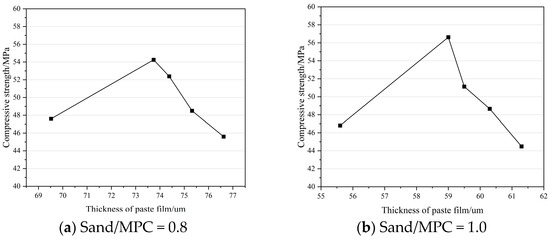
Figure 13.
The relationship between film thickness and compressive strength of MPC.
The results of relevant experiments indicate that the optimal sand–binder ratio for MPC mortar is 0.8. Under this condition, when the thickness of the paste film layer is between 73 μm and 74 μm, the workability and mechanical properties of MPC mortar can reach their optimal state.
4. Conclusions
In this paper, from the perspective of aggregate accumulation and paste film layer thickness, explored the influence of different sand gradation and sand–cement ratios on the thickness of the paste film layer, as well as the relationship between the thickness of the paste film layer and the working and mechanical properties of MPC. The following conclusions can be drawn:
(1) The concept of a paste film layer is proposed based on the aggregate accumulation model and equivalent particle size of particles. The influence of aggregate gradation and sand-to-paste ratio on the thickness of paste film is explored. These results provide a new idea for the study of the performance of MPC mortar.
(2) In the magnesium phosphate mortar system, there is a significant linear relationship between the thickness of the paste film layer and the slump flow of the mortar. It is indicated that the paste film layer’s thickness is the key factor affecting cement—based materials’ fluidity. This finding provides a basis for adjusting MPC mortar’s workability on construction sites. By controlling the paste film layer’s thickness, the fluidity requirements of different construction processes can be met, improving construction efficiency and quality.
(3) Unlike the workability, there is no significant linear relationship between the thickness of the paste film layer and the compressive strength of MPC mortar. Under different sand-to-cement ratios, the compressive strength shows a tendency to increase and then decrease with the thickness of the paste film layer increase, and there was a maximum value. In practical engineering, the mix proportion of MPC mortar can be optimized according to this rule to balance the mechanical properties and other performance requirements.
(4) Considering the limitation of the homogeneous circular particle assumption for aggregates in this study, future research can use more advanced techniques like 3D scanning technology to obtain the real—shape data of aggregates. By establishing a more realistic model, we can deeply investigate how the aggregate shape affects the filling characteristics and performance of MPC mortar. This will further enhance the prediction accuracy of filling density and provide more precise theoretical support for MPC mortar mix design.
Author Contributions
Data curation, Funding acquisition, Methodology, Project administration, Supervision, Writing–original draft, H.L.; Investigation, Writing–original draft, Writing–review and editing, H.Z.; investigation, original draft preparation, data curation, J.Z. (Jingyi Zhang); project administration, formal analysis, review and editing, J.Z. (Ji Zhang), J.Z. (Jian Zhang); supervision and validation, Y.T.; original draft preparation, data curation, P.Z. All authors have read and agreed to the published version of the manuscript.
Funding
This work was supported by the Open Fund of the National Engineering Research Center of Highway Maintenance Technology (Changsha University of Science and Technology), grant number kfj210105.
Institutional Review Board Statement
Not applicable.
Informed Consent Statement
Not applicable.
Data Availability Statement
The data presented in this study are available on request from the corresponding author.
Conflicts of Interest
Authors Ji Zhang and Peng Zhang were employed by Liaoning New Development Highway Technology Maintenance Co., Ltd. Authors Jian Zhang and Yu Tang were employed by Liaoning Datong Highway Engineering Co., Ltd. The remaining authors declare that the research was conducted in the absence of any commercial or financial relationships that could be construed as a potential conflict of interest.
References
- Jianming, Y.; Tao, L.; Xuancheng, X. Effect of fine aggregates on properties of magnesium potassium phosphate cement mortar. J. Mater. Civ. Eng. 2017, 29, 06017012. [Google Scholar] [CrossRef]
- Jiang, Y.; Ahmad, M.R.; Chen, B. Properties of magnesium phosphate cement containing steel slag powder. Constr. Build. Mater. 2019, 195, 140–147. [Google Scholar] [CrossRef]
- Yue, L.; Shi, T.; Li, J. Effects of fly ash and quartz sand on water-resistance and salt-resistance of magnesium phosphate cement. Constr. Build. Mater. 2016, 105, 384–390. [Google Scholar]
- Yang, Q.; Wu, X. Factors influencing properties of phosphate cement-based binder for rapid repair of concrete. Cem. Concr. Res. 1999, 29, 389–396. [Google Scholar] [CrossRef]
- Yang, Q.; Zhu, B.; Zhang, S.; Wu, X. Properties and applications of magnesia–phosphate cement mortar for rapid repair of concrete. Cem. Concr. Res. 2000, 30, 1807–1813. [Google Scholar] [CrossRef]
- Jiang, H.; Liang, B.; Zhang, L. Research on MPB Ultra-early-strength Concrete Repair Materials. J. Build. Mater. 2001, 196–198. [Google Scholar]
- Jiang, H.; Zhang, L. Research on Magnesium Phosphate Cement. J. Wuhan Univ. Technol. 2001, 32–34. [Google Scholar]
- Hall, D.A.; Stevens, R.; El-Jazairi, B. The effect of retarders on the microstructure and mechanical properties of magnesia–phosphate cement mortar. Cem. Concr. Res. 2001, 31, 455–465. [Google Scholar] [CrossRef]
- Hall, D.A.; Stevens, R.; Jazairi, B.E. Effect of water content on the structure and mechanical properties of magnesia-phosphate cement mortar. J. Am. Ceram. Soc. 1998, 81, 1550–1556. [Google Scholar] [CrossRef]
- Xu, B.; Lothenbach, B.; Ma, H. Properties of fly ash blended magnesium potassium phosphate mortars: Effect of the ratio between fly ash and magnesia. Cem. Concr. Compos. 2018, 90, 169–177. [Google Scholar] [CrossRef]
- Li, Y.; Chen, B. Factors that affect the properties of magnesium phosphate cement. Constr. Build. Mater. 2013, 47, 977–983. [Google Scholar] [CrossRef]
- Caliskan, S. Aggregate/mortar interface: Influence of silica fume at the micro-and macro-level. Cem. Concr. Compos. 2003, 25, 557–564. [Google Scholar] [CrossRef]
- Ahmad, M.R.; Chen, B. Effect of silica fume and basalt fiber on the mechanical properties and microstructure of magnesiumphosphate cement (MPC) mortar. Constr. Build. Mater. 2018, 190, 466–478. [Google Scholar] [CrossRef]
- Abadjiev, P.; Panayotov, K.; Petrov, S.I. Influence of condensed silica fume as admixture to concrete on the bond to the reinforcement. Constr. Build. Mater. 1993, 7, 41–44. [Google Scholar] [CrossRef]
- Rukzon, S.; Chindaprasirt, P. Strength, porosity, and chloride resistance of mortar using the combination of two kinds of pozzolanic materials. Int. J. Miner. Metall. Mater. 2013, 20, 808–814. [Google Scholar] [CrossRef]
- Lu, X.; Chen, B. Experimental study of magnesium phosphate cements modified by metakaolin. Constr. Build. Mater. 2016, 123, 719–726. [Google Scholar] [CrossRef]
- Huseien, G.F.; Mirza, J.; Ismail, M.; Ghoshal, S.K.; Ariffin, M.A.M. Effect of metakaolin replaced granulated blast furnace slag on fresh and early strength properties of geopolymer mortar. Ain Shams Eng. J. 2018, 9, 1557–1566. [Google Scholar] [CrossRef]
- Shafiq, N.; Nuruddin, M.F.; Khan, S.U.; Ayub, T. Calcined kaolin as cement replacing material and its use in high strength concrete. Constr. Build. Mater. 2015, 81, 313–323. [Google Scholar] [CrossRef]
- Westman, A.E.R.; Hugill, H.R. The packing of particles. J. Am. Ceram. Soc. 2010, 13, 767–779. [Google Scholar] [CrossRef]
- Furnas, C.C. Grading aggregates-I.-Mathematical relations for beds of broken solids of maximum density. Ind. Eng. Chem. 1931, 23, 1052–1058. [Google Scholar] [CrossRef]
- Stovall, T.; De Larrard, F.; Buil, M. Linear packing density model of grain mixtures. Powder Technol. 1986, 48, 1–12. [Google Scholar] [CrossRef]
- De Larrard, F.; Sedran, T. Optimization of ultra-high-performance concrete by the use of a packing model. Cem. Concr. Res. 1994, 24, 997–1009. [Google Scholar] [CrossRef]
- Yu, A.B.; Standish, N. Characterisation of non-spherical particles from their packing behaviour. Powder Technol. 1993, 74, 205–213. [Google Scholar] [CrossRef]
- Kwan AK, H.; Chan, K.W.; Wong, V. A 3-parameter particle packing model incorporating the wedging effect. Powder Technol. 2013, 237, 172–179. [Google Scholar] [CrossRef]
- Wong, V.; Kwan, A.K.H. A 3-parameter model for packing density prediction of ternary mixes of spherical particles. Powder Technol. 2014, 268, 357–367. [Google Scholar] [CrossRef]
- Tao, J.; Luo, X.; Huang, X.; Xiao, S. Influence of slurry film thickness and water film thickness on flowability of fresh concrete. China Concr. Cem. Prod. 2004, 30–34. [Google Scholar] [CrossRef]
- Huang, J.; Ji, W.; Yan, P. Relationship of workability and rheological properties of UHPC slurry and film thickness of particles. silicate bulletin. Bull. Chin. Ceram. Soc. 2022, 766–776. [Google Scholar] [CrossRef]
- Kwan, A.K.H.; Li, L.G. Combined effects of water film, paste film and mortar film thicknesses on fresh properties of concrete. Constr. Build. Mater. 2014, 50, 598–608. [Google Scholar] [CrossRef]
- Li, L.G.; Kwan, A.K.H. Concrete mix design based on water film thickness and paste film thickness. Cem. Concr. Compos. 2013, 39, 33–42. [Google Scholar] [CrossRef]
- GB/T 2419-2005; Test Method for Fluidity of Cement Mortar. Standards Press of China: Beijing, China, 2005.
- GB/T 17671-2021; Test Method for Strength of Cement Mortar (ISO Method). Standards Press of China: Beijing, China, 2021.
- Kwan, A.K.H.; Wong, H.H.C. Packing density of cementitious materials: Part 2-packing and flow of OPC+ PFA+CSF. Mater. Struct. 2008, 41, 773–784. [Google Scholar] [CrossRef]
- Wong, H.H.C.; Kwan, A.K.H. Packing density of cementitious materials: Part 1-measurement using a wet packing method. Mater. Struct. 2008, 41, 689–701. [Google Scholar] [CrossRef]
- Bilginer, B.A.; Erdoğan, S.T. Effect of mixture proportioning on the strength and mineralogy of magnesium phosphate cements. Constr. Build. Mater. 2021, 277, 122264. [Google Scholar] [CrossRef]
- Mao, W.; Cao, C.; Li, X.; Qian, J.; Dang, Y. An Experimental Investigation on the Effects of Limestone Fines in Manufactured Sands on the Performance of Magnesia Ammonium Phosphate Mortar. Buildings 2022, 12, 249. [Google Scholar] [CrossRef]
- Wang, Y.S.; Dai, J.G. Use of magnesia sand for optimal design of high performance magnesium potassium phosphate cement mortar. Constr. Build. Mater. 2017, 153, 385–392. [Google Scholar] [CrossRef]
Disclaimer/Publisher’s Note: The statements, opinions and data contained in all publications are solely those of the individual author(s) and contributor(s) and not of MDPI and/or the editor(s). MDPI and/or the editor(s) disclaim responsibility for any injury to people or property resulting from any ideas, methods, instructions or products referred to in the content. |
© 2024 by the authors. Licensee MDPI, Basel, Switzerland. This article is an open access article distributed under the terms and conditions of the Creative Commons Attribution (CC BY) license (https://creativecommons.org/licenses/by/4.0/).